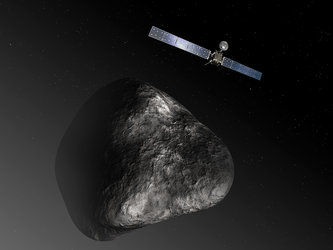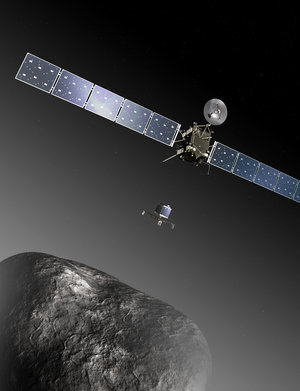Accept all cookies Accept only essential cookies See our Cookie Notice

About ESA
The European Space Agency (ESA) is Europe’s gateway to space. Its mission is to shape the development of Europe’s space capability and ensure that investment in space continues to deliver benefits to the citizens of Europe and the world.
Highlights
ESA - United space in Europe
This is ESA ESA facts Member States & Cooperating States Funding Director General Top management For Member State Delegations European vision European Space Policy ESA & EU Space Councils Responsibility & Sustainability Annual Report Calendar of meetings Corporate newsEstablishments & sites
ESA Headquarters ESA ESTEC ESA ESOC ESA ESRIN ESA EAC ESA ESAC Europe's Spaceport ESA ESEC ESA ECSAT Brussels Office Washington OfficeWorking with ESA
Business with ESA ESA Commercialisation Gateway Law at ESA Careers Cyber resilience at ESA IT at ESA Newsroom Partnerships Merchandising Licence Education Open Space Innovation Platform Integrity and Reporting Administrative Tribunal Health and SafetyMore about ESA
History ESA Historical Archives Exhibitions Publications Art & Culture ESA Merchandise Kids Diversity ESA Brand Centre ESA ChampionsLatest
Space in Member States
Find out more about space activities in our 23 Member States, and understand how ESA works together with their national agencies, institutions and organisations.
Science & Exploration
Exploring our Solar System and unlocking the secrets of the Universe
Go to topicAstronauts
Missions
Juice Euclid Webb Solar Orbiter BepiColombo Gaia ExoMars Cheops Exoplanet missions More missionsActivities
International Space Station Orion service module Gateway Concordia Caves & Pangaea BenefitsLatest
Space Safety
Protecting life and infrastructure on Earth and in orbit
Go to topicAsteroids
Asteroids and Planetary Defence Asteroid danger explained Flyeye telescope: asteroid detection Hera mission: asteroid deflection Near-Earth Object Coordination CentreSpace junk
About space debris Space debris by the numbers Space Environment Report In space refuelling, refurbishing and removingSafety from space
Clean Space ecodesign Zero Debris Technologies Space for Earth Supporting Sustainable DevelopmentApplications
Using space to benefit citizens and meet future challenges on Earth
Go to topicObserving the Earth
Observing the Earth Future EO Copernicus Meteorology Space for our climate Satellite missionsCommercialisation
ESA Commercialisation Gateway Open Space Innovation Platform Business Incubation ESA Space SolutionsEnabling & Support
Making space accessible and developing the technologies for the future
Go to topicBuilding missions
Space Engineering and Technology Test centre Laboratories Concurrent Design Facility Preparing for the future Shaping the Future Discovery and Preparation Advanced Concepts TeamSpace transportation
Space Transportation Ariane Vega Space Rider Future space transportation Boost! Europe's Spaceport Launches from Europe's Spaceport from 2012Latest
ESA Euronews: Rosetta: The Comet Hunter Awakes
Thank you for liking
You have already liked this page, you can only like it once!
The exploits of comet-hunting spacecraft Rosetta are generating intense interest as it speeds towards a dramatic climax this autumn.
The craft will catch up with comet 67p/Churyumov–Gerasimenko, fly alongside, and put a lander on its surface. Throughout this fantastic voyage, Euronews will have special access to the engineers and scientists who are making it happen.
On 20th January Rosetta woke up from two and a half years of hibernation. It was a moment of extreme tension for everyone at ESA's European Space Operations Centre in Darmstadt, Germany. Strained, nervous faces searched for a signal from a probe in deep space.
After some 45 minutes of anxiety the all-important first signal came through. The scientists burst into energetic applause.
ESA's Spacecraft Operations Manager, Andrea Accomazzo, expressed the emotions of those around him: "Getting it back is incredible, now we have one of the most fantastic adventures, one of the most challenging space missions ever."
So what is going to happen? Matt Taylor, Rosetta Project Scientist, explains: "The comet will approach the Sun, at its closest approach in summer of 2015, and that's where we'll see the most activity of the comet. One of the main questions that we want to answer with Rosetta is to observe this evolution from an inert object when it's out beyond the orbit of Jupiter to some highly dynamic and volatile object as it passes in this closest approach to the Sun."
Armelle Hubault, a Spacecraft Operations Engineer, spoke of the communications challenges in such a mission: "At the moment we're using a very low bitrate, so basically it takes a long time to talk to the spacecraft, we have to talk to it very very slowly, so one of our first activities actually is to change the mode of communication so that we can start talking much faster."
The are still difficult stages ahead, stressed Paolo Ferri, Head of Mission Operations: "We will switch on all units on board, we will test them, we will later in springtime switch on the scientific instruments, verify them. And this will bring us to the detection of the comet, we want the cameras on board the spacecraft to see the comet so that then we can manoeuvre the trajectory of the spacecraft to the right direction."
For Project Scientist Matt Taylor the mission is much more than a game of tag with a celestial body:
"It's not just about learning about the comet, by doing that we have this connection to how the solar system was formed, how the comet evolved within the early solar system, we can link that to the planetary formation and their early evolution, because the comets were there right at the formation of the solar system, and they were flung out into the deep freeze, storing this information, this primordial mix of material, and that gives us a clue to in fact ultimately where we come from as well."
-
CREDIT
ESA -
LICENCE
ESA Standard Licence
-
Documentary
-
-
-
-
-
-
-

ESA Euronews: Rosetta's quest for the origin of life

ESA Euronews: Comet Hunters: Rosetta's race to map 67P

Rosetta at comet

Rosetta - the comet chaser















 Germany
Germany
 Austria
Austria
 Belgium
Belgium
 Denmark
Denmark
 Spain
Spain
 Estonia
Estonia
 Finland
Finland
 France
France
 Greece
Greece
 Hungary
Hungary
 Ireland
Ireland
 Italy
Italy
 Luxembourg
Luxembourg
 Norway
Norway
 The Netherlands
The Netherlands
 Poland
Poland
 Portugal
Portugal
 Czechia
Czechia
 Romania
Romania
 United Kingdom
United Kingdom
 Slovenia
Slovenia
 Sweden
Sweden
 Switzerland
Switzerland

































